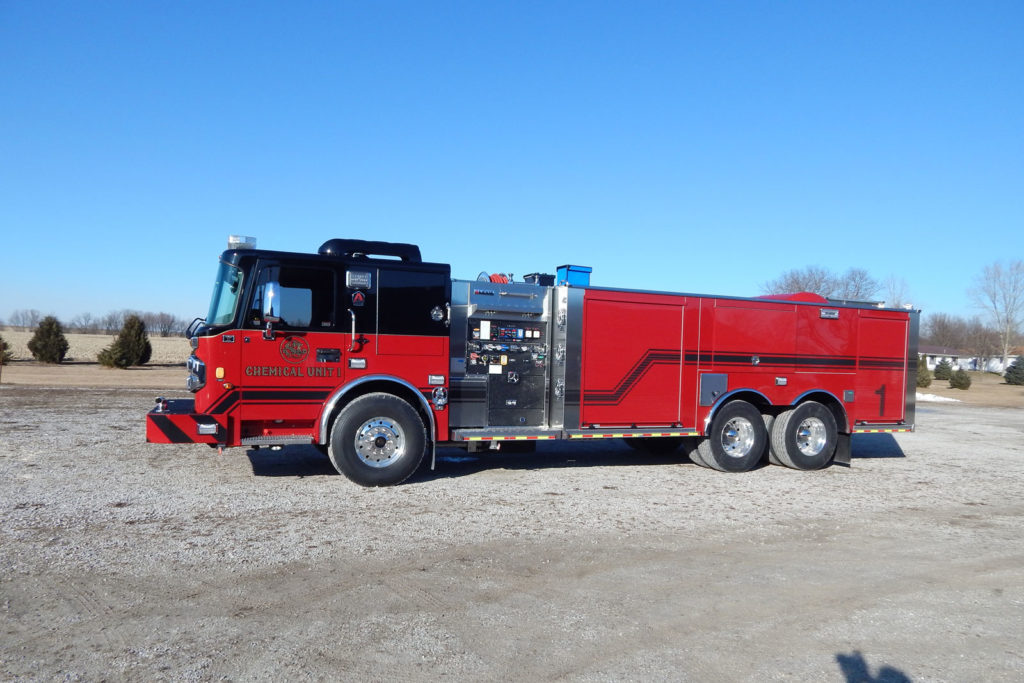
By Alan M. Petrillo
The St. Louis (MO) Fire Department historically had run foam trucks that were converted pumpers as well as a pumper with dual dry chemical and foam capabilities to handle fires in the city’s underground electrical vaults. The local electric utility, Ameren Missouri, was having issues with aging vaults, and after securing a $1 million funding grant, sat down with the fire department and developed a design for a specialized pumper that could better handle fires in its underground electrical vaults.

Mike Arras, St. Louis Fire Department deputy chief, says when firefighters would respond to an electrical vault emergency, they often would have to hold off attacking the fire while the utility isolated the vault and shut down electric power to it. “They checked with Seattle and San Francisco Fire Departments about their use of carbon dioxide (CO2) on underground electrical vault fires and found that the tactic had been successful in extinguishing fires in energized situations, so they wanted to use the grant money to develop a CO2 truck for St. Louis,” Arras says. “We needed to replace a dry chem/foam pumper because of its age, so we came up with a design that incorporated CO2, dry chemical, and foam on the pumper.”

Jeff Morris, president of Alexis Fire Equipment Company, says that building a pumper that carries a CO2 extinguishing system was a first for Alexis. “St. Louis Fire and Ameren came to us and said, ‘Here’s what we want to do, and here’s what we want the pumper to carry,’ ” Morris says. “They knew what they wanted and allowed us to engineer it and make it work for them. The biggest challenge was getting the 5,000-pound CO2 unit in the right place on the vehicle so that the weight balance is right. And, we also had to consider that the pumper also was going to carry foam and dry chemical tanks and had to get them in the right place.”

Morris says the resulting pumper is built on a Spartan Metro Star LFD tandem rear axle chassis and cab with a heavy-duty stainless steel body and subframe powered by a Cummins 450-hp L9 diesel engine and an Allison 3000 EVS automatic transmission. Wheelbase on the pumper is 234 inches, overall length is 37 feet 2 inches, and overall height is 9 feet 9 inches, with a front axle weight rating of 20,000 pounds and a rear axle weight rating of 40,000 pounds.
Arras notes the rig has a Hale Qtwo 2,000-gpm two-stage pump with side-mount controls, a Williams WATP 500V around-the-pump foam system, a 5,000-pound TOMCO carbon dioxide refrigerated DOT delivery unit, a Vanner 3000 inverter, an 800-gallon foam tank holding NovaCool UEF firefighting foam, a 300-gallon polypropylene water tank, and a 500-pound Amerex dry chemical skid on an electrically actuated roll-out tray at the rear of the pumper.
The pumper has a 2½-inch preconnect in the 18-inch extended front bumper, two 6-inch nongated suction inlets, two 4-inch discharges, one 2½-inch discharge on the right side, and a Hannay booster reel with 150 feet of one-inch hose. Turtle Tile is on installed the floors of all the compartments, which are covered by painted ROM roll-up doors, and the pumper has a Weldon Vista IV touch screen display, a Federal EQ2B siren with a 200-watt speaker, two Hadley air horns in the front bumper, a Whelen LED warning lights package, Whelen LED scene lights at the rear, and FRC LED scene lights on each side.
Arras notes that the department is now able to work an energized fire situation in a vault. “We have a special nozzle that we drop down into the vault and inject the CO2 into the system which inerts the whole space,” he says. “We throw the cover over the top to hold the CO2 in place, which puts the fire out, meaning damage to the vault’s equipment is not continuing while the utility is working to deenergize it.”
ALAN M. PETRILLO is a Tucson, Arizona-based journalist, the author of three novels and five nonfiction books, and a member of the Fire Apparatus & Emergency Equipment Editorial Advisory Board. He served 22 years with the Verdoy (NY) Fire Department, including in the position of chief.

